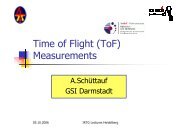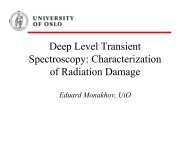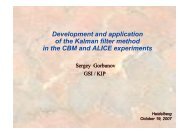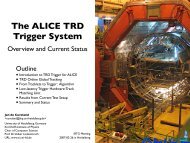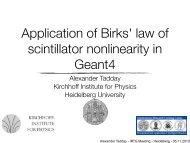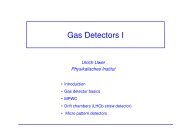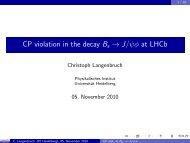Open Charm D0 Everard CORDIER (Heidelberg) - IRTG Heidelberg
Open Charm D0 Everard CORDIER (Heidelberg) - IRTG Heidelberg
Open Charm D0 Everard CORDIER (Heidelberg) - IRTG Heidelberg
You also want an ePaper? Increase the reach of your titles
YUMPU automatically turns print PDFs into web optimized ePapers that Google loves.
<strong>Open</strong> <strong>Charm</strong><br />
<strong>Everard</strong> <strong>CORDIER</strong> (<strong>Heidelberg</strong>)<br />
Grako meeting HD, April 28, 2006 <strong>Everard</strong> Cordier
OUTLINE<br />
• Motivations :<br />
– Dense hadronic matter and heavy-ion<br />
collisions<br />
– <strong>Charm</strong><br />
• <strong>Charm</strong> measurements (NA50)<br />
• CBM at FAIR<br />
• Summary
Heavy-Ion collisions at intermediate energies<br />
Lattice QCD calculations predict a<br />
critical point :<br />
- high μ B : 1 st order phase transition from<br />
baryonic medium to QGP<br />
- low μ B : continuous transition<br />
Measurements (SIS, AGS, SPS and<br />
RHIC) of chemical freeze-out<br />
-Reproduced by thermal models<br />
Beam energies 10 – 45 AGeV give<br />
access to:<br />
highest baryon densities<br />
(Au+Au@20AGeV at SIS 200 : ρ ≈7ρ 0 )<br />
onset of phase transition (?)<br />
critical point (?)
Trajectories in the QCD phase diagram<br />
V.Toneev et al., nucl-th/0309008<br />
3 fluid hydro calculation<br />
with hadron gas EOS<br />
phase boundary reached<br />
already at 10 AGeV<br />
predicts 30 AGeV to hit<br />
critical point
Indications for onset of deconfinement at low<br />
SPS energies<br />
NA49 (QM 2004)<br />
•Peak in strange/nonstrange yield ratio<br />
•Plateau of kaon slopes at SPS<br />
→not satisfactorily explained in hadronic scenarios<br />
Change of baryochemical potential ? Or Phase<br />
transition ?<br />
→Can be modeled assuming 1st order phase transition
• Quark masses (MeV):<br />
– u ≈ 1-5<br />
– d ≈ 5-10<br />
– s ≈ 80-150<br />
– c ≈ 1000-1400<br />
– b ≈ 4100-4400<br />
– t ≈ 170000<br />
<strong>Charm</strong><br />
<strong>Charm</strong> : “intermediate” mass<br />
Not light (massless), not heavy<br />
Can we apply pQCD (small α S ) for<br />
calculations ?<br />
• D 0 (cu)<br />
– mass 1864.5 MeV<br />
– Mean life :<br />
τ = 412 .10 -15 s<br />
cτ = 123.4 μm
In-Medium Effects<br />
D meson masses are<br />
expected to drop in<br />
dense environment<br />
should have strong<br />
effect on production<br />
yield<br />
Medium effects best<br />
studied near<br />
threshold
<strong>Open</strong> <strong>Charm</strong> enhancement (?) at SPS Pb+Pb<br />
NA50<br />
NA50<br />
• NA50 measured di-muon distribution in 1.5
Facility for Antiproton and Ion<br />
Research<br />
Experiments :<br />
• CBM (Compressed Baryonic Matter)<br />
• PANDA (Proton ANtiproton DArmstadt)<br />
• The SuperFRS Project<br />
• NUSTAR – International Nuclear<br />
Structure and Astrophysics Community<br />
• SPARC – Stored Particles Atomic Physics<br />
Research Collaboration<br />
• The FLAIR (Facility for Low-Energy<br />
Antiproton and heavy-Ion Research)<br />
• ELISe – ELectron-Ion Scattering in a<br />
Storage Ring (eA collider)<br />
FAIR @ GSI<br />
SIS 100 Tm<br />
SIS 300 Tm<br />
U: 35 AGeV<br />
p: 90 GeV
STS<br />
( 5 – 100 cm)<br />
RICH<br />
(1,5 m)<br />
TRDs<br />
(4,6,8 m)<br />
TOF<br />
(10 m)<br />
ECAL<br />
(12 m)<br />
STS<br />
tracking,<br />
displaced vertices<br />
CBM@FAIR<br />
Baseline detector concept<br />
RICH<br />
electron ID<br />
TRD<br />
electron ID<br />
TOF<br />
hadron ID<br />
ECAL<br />
lepton ID<br />
photons
The physics of CBM<br />
? !<br />
deconfinement at high ρ B<br />
in-medium properties<br />
of hadrons<br />
critical point<br />
strangeness (K, Λ, Σ, Ξ, Ω)<br />
charm (J/ψ, D)<br />
flow<br />
ρ, ω, φ → e + e -<br />
open charm<br />
fluctuations
Au+Au@25AGeV<br />
• Total 800-1000 part/event<br />
– 328 π +<br />
– 357 π -<br />
– 161 P<br />
– 41 K +<br />
– 13 K -<br />
– 9 Σ -<br />
– 8 Σ +<br />
– D 0 yield predicted by HSD model :<br />
1.2-1.4 .10 -4 /central event : rare probe<br />
(D 0 → K - + π + branching ratio 3.8%)<br />
→ Need high beam (interaction) rate :<br />
10 9 ion/s (10 7 reaction/s with 1% target)
The Silicon Tracking System<br />
vertexing<br />
1<br />
vacuum<br />
3<br />
4<br />
tracking<br />
pixel detectors strip detectors<br />
2<br />
z = 5,10,(20) cm<br />
5<br />
z = (20),40,60,80,100 cm<br />
Requirements<br />
• Operation in mag field<br />
• Close to target<br />
• Radiation hardness<br />
• High granularity<br />
• Minimal thickness<br />
6<br />
7<br />
"minimal setup":<br />
3 pixel stations<br />
4 strip stations<br />
momentum resolution < 1 %
PID : mass resolution<br />
σ m 2 ≈ p 2 σt /β 2 t<br />
CBM-TOF<br />
• Interaction rate 10 7 Hz (~1000 tracks /event)<br />
• TOF wall at 10m from target from 3º to 27º<br />
• Rate from 1kHz/cm 2 (27º) to 20kHz/cm 2 (3º)<br />
– Hit density from 6.10 -2 /dm 2 to 1/dm 2 , more than<br />
60000 cells to have occupancy below 5%<br />
– Total area >60m 2
Detector performance: D mesons<br />
Displaced vertex resolution<br />
Challenge: Implementation<br />
of secondary vertex cut in<br />
online event selection<br />
(reduction ≈ 1000 needed)<br />
Simulation: STS only (no PID)<br />
with MAPS<br />
10 11 events
Simulation Status<br />
Results with tracking only :<br />
This spectrum corresponds to 10 12<br />
minimum bias interactions (≈ 4 months of<br />
data taking at 0.1 MHz interaction rate)<br />
• All tracks : Perfect PID<br />
• Single track cuts : χ 2 distance to the<br />
primary vertex, p-cut, pt-cut<br />
• z-vertex cut (250 μm)<br />
• All cuts : D 0 pointing cut, geometrical<br />
vertex χ 2 cut<br />
→ 104 events (8.5% efficiency)<br />
Gorbunov, Kisel and Vassiliev<br />
<strong>Everard</strong> Cordier
<strong>D0</strong> Reconstruction<br />
Urqmd (Au+Au@25AGeV) Ds signal (0°< θ < 30°)<br />
No Background<br />
Effi<br />
~ 5%
Summary<br />
• Heavy-ion collisions can reach new<br />
states of matter (QGP?)<br />
• <strong>Charm</strong> is an important probe to study the<br />
modifications in the medium, the phase<br />
transition and the critical point<br />
• NA50 measured an open charm<br />
enhancement (?) by a factor 3<br />
• <strong>Open</strong> charm production near threshold<br />
can be measured in CBM
<strong>Charm</strong> and single electron at RHIC<br />
Simulation before RHIC PHENIX data (PRL88)<br />
• At RHIC, it is expected that charm decay can be the dominant component of single<br />
electron in pt > 1.5 GeV/c<br />
– Large production cross section of charm ( 300-600 ub)<br />
– Production of the high pt pions is strongly suppressed relative to binary scaling<br />
– Production of charm quark roughly scale with binary collisions.<br />
• PHENIX observed “excess” in single electron yield over expectation from light meson<br />
decays and photon conversions Observation of charm signal at RHIC



